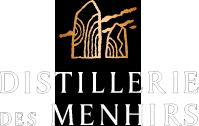 Welcome
Welcome
To acces this website, you must be of legal age to consume alcohol in your country of residence.
- Yes
- No
25 years ago, Guy LE LAY, true to his enthusiastic and stubborn nature, was ready to rise to the challenge of creating the first ever buckwheat whisky in the world.
But he soon realised that choosing buckwheat would be complicated as this cereal is not a productive crop.
It yields far less than barley (approximately 15 quintals per hectare rather than 70 quintals for barley – 10 quintals = 1 tonne). What is more, its alcohol yield is half that of barley. These drawbacks didn’t stop him as he realised that buckwheat develops extraordinarily powerful flavours. Getting the work started was no mean feat and after several aborted attempts, Guy LE LAY realised that he couldn’t go it alone. From that point on, he was guided by renowned experts.
He gave Pierre Durroset, researcher in the Food Quality Institute ADRIA, the responsibility of perfecting the malting, brewing and fermentation operations.
Then Guy LE LAY managed to get the international spirits expert, Robert Leauté, interested in the project. He was a Master Blender in Cognac and a famous tasting specialist. He initiated Guy into the art of distilling, ageing and blending. From this fruitful partnership, EDDU whisky was born, “Eddu” meaning “buckwheat” in the Breton language.
Distilling is done in two traditional pot stills, each containing 2500 litres: a cross between Scottish pot stills and Cognac stills.
The still is made up of a copper boiler mounted in a frame.
The boiler is capped with a cone shaped head which stretches out into a swan neck which coils down through a condenser. Distillation is done in 2 successive “chauffes” (heatings).
During the first distillation, the malted, fermented buckwheat, known as wash, is brought to the boil in the boiler. The steam rises up into the head before going through the swan neck and down through the coils in the condenser. The distillate collected is between 25 and 28%vol.
The second distillation is called “bonne chauffe” (good heating). During this delicate operation the” foreshots” and “aftershots”,the first and the last fractions of the new-make spirit, are taken out and only the “middle cut” is kept: this is the clear, aromatic 70% vol, whisky.
Contrary to modern practices where pot stills are steam heated, only a small number of craft distilleries, including the Distillerie des Menhirs, still heat stills by naked flame. This is a far more difficult technique, but which creates unparalleled cooking aromas.
The distillate is then transferred into casks for ageing.
Casks are not neutral containers: they progressively impart their finest aromas, flavours and colours into the whisky.
The Distillerie des Menhirs mainly uses:
Upon entering the cathedral-cellar, visitors are welcomed by pungent aromas escaping from the oak staves. This natural evaporation, poetically called “angels’ share” represents 3% of the casks’ contents per year.
In Brittany, the weather conditions are a real godsend for whisky maturing. Humidity is very similar to that of Ireland and Scotland, but milder temperatures are a distinct advantage for ageing. During ageing, the Distillerie des Menhirs perpetuates the art of old fashioned diluting.
This consists in gradually adding demineralised spring water to the whisky and diluting it to the desired percentage of alcohol. When the time is right, the Cellar Master, Kévin LE LAY, creates blends from the best characteristics of each batch of whisky, dilutes one last time before bottling, which is done on site at the Distillerie des Menhirs.
 Welcome
Welcome
To acces this website, you must be of legal age to consume alcohol in your country of residence.